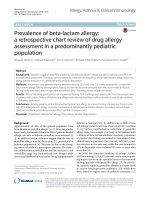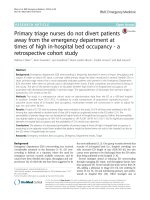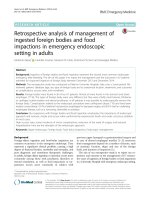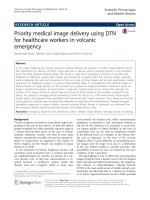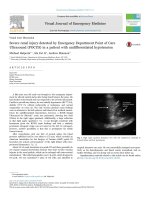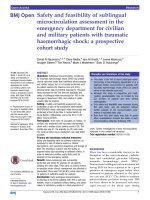Pediatric emergency medicine trisk 365
Bạn đang xem bản rút gọn của tài liệu. Xem và tải ngay bản đầy đủ của tài liệu tại đây (116.98 KB, 4 trang )
may reveal leukocytosis and/or thrombocytosis. CSF usually shows a pleocytosis,
with a lymphocytic predominance. Sterile pyuria is sometimes noted. In some
cases of Kawasaki disease, findings consistent with myocardial ischemia or an
arrhythmia may be noted on ECG, and coronary artery aneurysms may be
discovered with an echocardiogram.
Endocrine Disorders (See Chapter 89 Endocrine
Emergencies )
Infants with congenital adrenal hyperplasia (CAH) usually present in the first
few weeks of life with a history of vomiting, lethargy, or irritability. Signs of
marked dehydration may be present with tachycardia and possibly hypothermia.
History may reveal that these infants have been poor feeders since birth and the
symptoms may be progressive over a few days. The physical examination can be
helpful in females if ambiguous genitalia are noted. The presence of marked
hyponatremia with severe hyperkalemia on laboratory evaluation suggests CAH.
Other findings in this disorder include hypoglycemia and metabolic acidosis.
Evaluate for peaked T waves or arrhythmias on ECG as hyperkalemia may result
in sudden cardiac arrest. Elevated 17-hydroxyprogesterone and renin, with
decreased serum aldosterone and cortisol, confirm the diagnosis of CAH.
Metabolic Disorders
Prolonged diarrhea or vomiting can produce hypoglycemia, dehydration,
electrolyte disturbances, and acid–base abnormalities such that an infant will
appear quite ill. Young infants with diarrhea may develop marked hyponatremia
caused by sodium losses or iatrogenic water intoxication. The latter occurs when
well-meaning parents feed excess free water or improperly mix concentrated
formula, leading to a rapid drop in serum sodium. Such infants may appear
lethargic, with slow respirations, hypothermia, and, possibly, seizures that are
difficult to control. Likewise, dehydrated infants with hypernatremia may be
lethargic or irritable, with muscle weakness, seizures, or coma. Persistent
vomiting may lead to hypochloremic alkalosis with hypokalemia, causing
weakness or cardiac dysfunction (see Chapters 22 Dehydration and 100 Renal
and Electrolyte Emergencies ).
A special cause of hyponatremic dehydration to consider is cystic fibrosis .
Vague symptoms in the history include poor feeding, poor growth, and increased
lethargy. The parents may report that the infant gets ill in hot weather and that the
baby’s skin tastes salty. The baby may have also had meconium plug syndrome
(transient distal colonic obstruction caused by inspissated meconium), prolonged
jaundice, or prior pulmonary symptoms such as cough, tachypnea, or pneumonia.
Laboratory tests show profound hyponatremia that is not accounted for by
gastrointestinal losses. A sweat test or DNA analysis will help confirm the
diagnosis.
Rare inborn errors of metabolism, such as inherited urea cycle disorders , may
produce vomiting in young infants, who will then present with lethargy, seizures,
or coma resulting from metabolic acidosis, hyperammonemia, or hypoglycemia
(see Chapter 95 Metabolic Emergencies ). Galactosemia is due to a genetic defect
in the metabolism of galactose and presents with vomiting, acidosis, failure to
thrive, and jaundice when exposed to this sugar. Hypoglycemia and liver
dysfunction with coagulopathy are often present, and many develop urinary tract
infections or sepsis due to gram-negative organisms. Testing with a CBC,
electrolytes, bicarbonate, blood glucose, liver function (including coagulation
studies), urinalysis for ketones, and plasma ammonia levels is indicated in young
infants with gastroenteritis, lethargy, or irritability to evaluate for metabolic
conditions. Collect extra plasma (2 mL) and urine (5 mL) for additional testing,
ideally before providing fluid resuscitation and dextrose. Inquiry about neonatal
screening is important; consider sending a follow-up blood filter paper specimen
to the newborn screening laboratory. Rapid bedside testing for glucose and
sodium is recommended for immediate recognition and therapy. Hypoglycemia
also can be secondary to sepsis, certain drugs, or alcohol intoxication.
Young infants are incapable of accidental ingestions, but one should consider
toxins (see Chapter 102 Toxicologic Emergencies ) in certain cases. Wellmeaning parents may rarely cause salicylism in their attempts to aggressively
treat fever with aspirin. Affected infants can then present with vomiting,
hyperpnea, hyperpyrexia, convulsions, or coma. The history of medication given
is crucial because the physical examination will not distinguish this ill baby from
the infant with sepsis. The laboratory evaluation may lead to the suspicion of a
metabolic problem because abnormalities of sodium, blood sugar, or acid–base
balance are often found. Moreover, hypokalemia can be seen in salicylism, as
well as abnormal liver function or renal function studies. An elevated salicylate
level in the serum confirms the diagnosis of aspirin poisoning, but in chronic
poisoning, the aspirin level may be relatively low, even in patients with a fatal
course.
Carbon monoxide poisoning may present as an unknown intoxication when
families are unaware of a defective heating system in the home. A history of
sluggishness, poor feeding, vomiting, and other family members who are also ill
with headache, syncope, or flu-like symptoms that improve after leaving the
home environment, suggest this poisoning. The classic “cherry red” skin color
may be lacking, and physical examination may reveal only lethargy. Elevation of
the carboxyhemoglobin level is diagnostic.
Renal Disorders (See Chapter 100 Renal and Electrolyte
Emergencies )
A young infant may also appear extremely ill because of renal failure or
dysplasia. Posterior urethral valves, especially in males, can cause bladder outlet
obstruction and resultant renal failure. Approximately one-third of these cases are
diagnosed by 1 week of age, but more than half go undetected for the first few
months of life. The parents may give a history of vomiting, poor appetite,
inadequate weight gain, or an abdomen that appears swollen. A careful review of
systems may reveal a weak urinary stream. On physical examination,
hypertension or an abdominal mass (hydronephrosis) may be detected, as well as
urinary ascites. A suprapubic ultrasound may demonstrate the dilated posterior
urethra and bladder and a voiding cystourethrogram will show a dilated posterior
urethra, hypertrophy of the bladder neck, and trabeculated bladder. The serum
creatinine and blood urea nitrogen levels may be markedly elevated. Urosepsis is
a possible complication of posterior urethral valves.
Hematologic Disorders
Any infant with severe anemia caused by aplastic disease, hemolytic process, or
blood loss can look quite ill (see Chapter 93 Hematologic Emergencies ).
Disorders of hemoglobin such as methemoglobinemia can also cause an infant to
appear toxic and may be inherited or acquired. Transient methemoglobinemia in
infants is occasionally caused by environmental toxicity from oxidizing agents
such as nitrates found in well water or oxidant drugs (e.g., topical benzocaine in
teething gels). This intoxication presents with cyanosis, poor feeding, failure to
thrive, vomiting, diarrhea, and lethargy. In other patients, the oxidant stress is less
obvious, causing severe diarrhea and metabolic acidosis. It is postulated that the
infectious agent that causes the diarrhea or the secondary metabolic acidosis may
produce an oxidant stress that leads to methemoglobin formation. These infants
are lethargic, with hypothermia, tachycardia, tachypnea, and hypotension, and
often appear mottled, cyanotic, or ashen. One key to the diagnosis of
methemoglobinemia is that oxygen administration does not affect the cyanosis
(similar to CHD with right-to-left shunt). Laboratory tests show a profound
acidosis (pH 6.9 to 7.2), yet the PaO 2 is normal despite the cyanosis.
Leukocytosis and thrombocytosis are present, and prerenal azotemia may be
noted. The blood itself may appear chocolate brown (most easily noted when a
drop of blood on filter paper is waved in the air and compared with a normal
control), and methemoglobin levels will be elevated up to 65% (normal 0% to
2%). Hemoglobin electrophoresis will be normal (except in rare cases of
hemoglobin M), as is the glucose-6-phosphate dehydrogenase assay in most
cases. With appropriate treatment, the methemoglobin level returns to normal.
However, death can occur from methemoglobinemia in infants if not treated
promptly.
Kernicterus, or bilirubin encephalopathy (see Chapter 96 Neonatal
Emergencies ), should be considered in the septic-appearing infant with
neurologic findings. This usually occurs in the first week of life in jaundiced
neonates due to the deposition of indirect bilirubin in the basal ganglia and
brainstem nuclei. Premature infants are more susceptible to kernicterus, but the
majority of infants who develop kernicterus are healthy, term infants who
predominantly breast-feed. Lethargy and decreased feeding present early, and
with progression the infant will develop respiratory distress and neurologic signs,
including decreased reflexes, a high-pitched cry, arching, opisthotonic posturing,
twitching of the extremities, and convulsions. The neonate can even develop a
bulging fontanel, making it difficult to differentiate from meningitis on clinical
examination. Laboratory evaluation is crucial; obtain total and direct bilirubin
counts, a CBC, blood typing, and Coombs test. Kernicterus usually does not
develop until the total bilirubin level has exceeded 25 to 30 mg/dL, but toxicity
has occurred at levels as low as 20 mg/dL.
Gastrointestinal Disorders (See Chapter 91 Gastrointestinal
Emergencies )
Gastroenteritis in an infant can rapidly lead to profound dehydration and shock.
Hypoglycemia is also common in these young infants and can cause lethargy and
coma. Bacterial infections such as Salmonella may cause sepsis in a young infant,
and viral agents may mimic this. A history of bloody diarrhea suggests bacterial
gastroenteritis. A CBC with many band forms despite a normal white blood cell
(WBC) count suggests Shigella infection. Stool cultures will diagnose infections,
but a few days are needed for bacterial isolation and viral isolation takes even
longer. Rapid PCR detection of common gastrointestinal pathogens in stool is
available at many institutions. Fluid resuscitation may improve the infant’s
appearance and make dehydration the likely diagnosis.
There are several intra-abdominal surgical emergencies that mimic sepsis. The
underlying pathophysiology is some combination of hypovolemia, electrolyte
disturbances, hypoglycemia, and/or metabolic acidosis. Small bowel obstruction
(SBO) caused by volvulus , intussusception , or incarcerated hernia will generally


